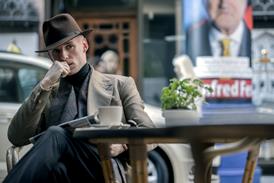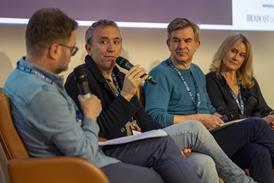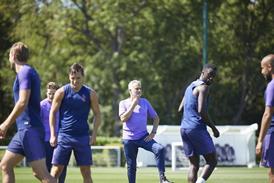Articles about the state of children's TV usually make for depressing reading. Yet while it's true that the UK market, especially for animated series, has been in crisis for some time, this doesn't seem to have hampered the amount of innovation in the sector, both in terms of ideas and technology.
According to Aardman's head of broadcast and development, Miles Bullough, the main difficulty for UK animators is obtaining funding. Bullough identifies the withdrawal of CiTV from kids commissioning, budget cuts at the BBC and withdrawal by Five from older kids commissioning as the main problems. Bullough, like many of the producers we polled, is a strong supporter of the Pact call for tax credits for kids programming (see www.pact.co.uk). “The industry is being critically starved of cash and is almost at breaking point,” agrees Anthony Utley, managing director of Cosgrove Hall Films (CHF). “Broadcasters with not enough slots or money are flooded with good ideas from too many producers. Faster feedback from broadcasters would help.”
The global stage
However bleak the picture looks, many of the UK animation companies are still in business. “This probably relates to the fact that all the filleting started a long time ago,” says Red Kite managing director Ken Anderson. “We have recently seen a UK animated short (Peter and the Wolf) win an Oscar and there are still world-class animation companies producing work for the global advertising industry. Our games companies are attracting animators into their ranks and out of them again. The mobile/internet market is still developing and looks as if it will be the future for many animators.”
Anderson, whose studio has most recently seen success with The Imp (Cartoon Network and worldwide distribution), 64 Zoo Lane (CBeebies) and The Secret World of Benjamin Bear (Family Channel), says that UK animators need to innovate and bring their talents - particularly for design and humour - to the fore. He adds: “We need to have an international outlook and the courage to compete on the global stage.”
Aardman is one company that is doing just that. “We're working with more international commissioning teams and looking at different deal and financing structures,” states Bullough. One of these international partners is Cartoon Network, a division of Turner, which is working with Aardman on the forthcoming CGI series Chop Socky Chooks. Last year it opened the Cartoon Network Development Studio Europe, which aims to generate and develop original animation series. “When we greenlight our first show we will hire a separate European animation studio space and pre-production team,” says Daniel Lennard, vice-president of original series & development at Cartoon Network Europe. “However, it's significantly cheaper to animate your show in Asia than it is in the UK. Until this disparity is solved, UK producers will continue to ship animation overseas for traditional 2D series. There are occasions when series can be animated in the UK, using Cel Action software, for example, but this isn't always appropriate, depending on the show.”
Funding solutions
Like Aardman, animation veteran Graham Ralph, of Silver Fox Films, is looking abroad for funding. “The government ban on junk food advertising while worthy has crippled small production companies trying to raise money for productions,” he says. “We are working with international partners. Our main challenge is adapting to these markets. We need to try to create programmes that will sell internationally and keep the UK at the top.”
Blue-zoo is also developing properties with international -and multichannel - potential, according to Oli Hyatt, the company's co-founder and head of development. “It's essential the property has life outside television, something that keeps it in the mind or on the shelf, for the all-important merchandising revenues,” he says.
This drive to consider other opportunities for content is becoming the norm for producers and broadcasters alike. “Almost all our concepts now include opportunities for non-broadcast exploitation,” says CHF's Utley. “Apart from anything else, it's impossible to get shows funded from broadcast alone so it's necessary to develop ideas which naturally encompass further exploitation. One such versatile in-house CHF production is Eddie Retractorhead, picked up by Nickelodeon as a series of 10 x 1-minute interstitials, which could also suit online and mobile platforms.
Trimedia approach
This is also a route preferred by CBeebies, which is required to look at concepts that cover interactive, radio and TV for its pre-school audience. Kay Benbow, head of CBeebies production, animation & acquisitions, says CBeebies' trimedia approach has created a strongly integrated and effective unit. “We have probably the smallest budget of any BBC channel, but I would argue that CBeebies punches hugely above its weight,” she says. “We have a creative community of people focused on the CBeebies audience, feeding in for example where animation might work in a project at a very early stage or where we need to think about the interactive elements.”
Benbow points to Tommy Zoom as an example of a successful leap from web to TV and firm evidence that CBeebies is helping develop UK animation. She highlights Sesame Workshop's Pinky Dinky Doo (once the US soundtrack was adapted for a UK audience) as another recent CBeebies success with an interactive element.
“Producer Alternative View hadn't worked on long-form animation until Tommy Zoom,” says Benbow. “Around 95% of our titles originate from the UK. We endeavour to support the UK animation industry as a whole from fledgling animators that we use in our CBeebies productions, such as Space Pirates, through to scriptwriters and voice artists. We are also working with blue-zoo on Kerwhizz, a 26-episode CBeebies show aimed at four to six year olds which features interaction between viewers and a cast of on-screen CGI characters who take part in a race in a live-action environment.”
The format is supported on the web and in podcast form.
Blue-zoo's head of production Adam Shaw says: “Everyone is looking at non-broadcast methods such as computer games and mobiles for inspiration, but what is essential is the ideas they envisage encompass all platforms, offering the full 360-degree experience. The process is not as linear as it used to be. It's no longer the case that TV solely feeds the internet. Sometimes the internet feeds TV and, in the best cases, is the essential part.”
Cartoon Network's Lennard adds that whatever the medium, story and characters always come first. “Traditionally, interesting characters and developed story-lines come from show creators, rather than the gaming world. But the talent is merging between these two forms and the distinction may disappear. We are currently co-producing a show called Hero 108 with Mike Young Productions and a Taiwanese gaming company called Gamania. It started off as a concept for a game and it will have a strong web/mobile/gaming presence, but the show still needs to stand on its own.”
Hybrid productions
Cartoon Network's experience of collaborating with non-broadcast partners on new formats that will work across different platforms is increasingly common, as KidsCo TV managing director Paul Robinson reveals.
“KidsCo is mainly a linear TV channel, but we are launching non-linear services such as the branded KidsCo video-on-demand service on Hanaro in South Korea,” says Robinson. “We will continue to look for new opportunities and are also talking to a computer games company about a hybrid product for both platforms.”
For his part, Marc Buhaj, senior vice-president of programming at Jetix Europe, reveals that his network's linear TV star Pucca began as a Korean graphic-based property that appeared online, while conversely two of the new animated series on the channel, Jimmy Two Shoes and Kid vs Kat, come from established producers. “However, with these two shows we are ensuring that along with the traditional half-hour order for these series, we are producing elements specifically for alternative platforms,” he says.
Technology is changing too. As well as software like Cel Action and Toon Boom Studio that has enabled smaller studios to make production-level 2D animation, new techniques are constantly being applied. “For the Jetix audience of kids aged six to 14 we predominantly work with a combination of 2D, CG and Flash,” says Buhaj. “Stop-motion tends to appeal to a younger audience. However, great strides are being made all the time. The CG/2D mix of Galactik Football Two (produced by Alphanim) is impressive - as is Marathon Media's CGI work on Monster Buster Club. However, even traditional 2D shows such as SIP Animation's Combo Ni-os have a sharp look to them. We are now at a point where we require HD as a basic output from our partners.”
Rupert Bear - Follow the Magic (Entertainment Rights/Cosgrove Hall Films) was shot with HD cameras specially developed for Cosgrove Hall. “Although we used traditional stop-frame sets and puppets, the series was shot against blue and green-screen backgrounds with the backdrop added in post, thus giving a much greater depth of field to the show,” says Utley.
When it comes to older kids, the challenge is keeping the production relevant. After extensive research into pre-teen attitudes and issues, Pineapple Squared Entertainment has produced the visually rich Adventures on Orsum Island for VGI Entertainment. Made at Shepperton Studios, the 4K high-definition 3D series uses the latest motion-capture technology on real backgrounds. Chris Blackburn, managing director of VGI, says: “The picture quality on Orsum Island creates a convincing illusion of realism.If you couple 4K with motion capture, you are watching the movements of real actors transposed onto crisp animation. It looks as if it belongs in the cinema.”
Cartoon Network's Lennard adds that pre-teen project Chop Socky Chooks combines the immediacy of CG and the stylish design of a 2D property with Aardman performance and production values. “When executed well, CG has the ability to immerse kids into that world more completely than 2D. But a show's long-term success comes down to great characters and great storytelling, regardless of animation technique.”
Freefonix
TX: Spring 2008
Broadcaster: BBC1/CBBC
Format: 40 x 30-minute series, 3D CGI
Production Company: Cinnamon Entertainment (UK)/Method Films (Paris)
Cinnamon Entertainment's Freefonix is a music-driven 3D CGI-animated series aimed at creating a distinct style and an engaging world for pre-teens. It follows the adventures of a band with special powers battling against evildoers and offers mixed genre components on TV, web and mobile.
“With Freefonix, we have over 50 original music tracks which were created for the show by a team of the UK's top record producers,” says Chris Rice, producer of Freefonix and one of the directors at Cinnamon. “In conjunction with this we have mobisodes and a full inter-active web experience, featuring elements such as U-MYX which enable kids to simply re-mix their own Freefonix tunes and post online.
“We wanted to use Toonshaded 3D as the animation technique for Freefonix, as it allowed for the energy and camera moves of 3D,” continues Rice. “However, a Toonshaded 2D render allowed us to keep a more graphic look, with influences ranging from 1950s/1960s design through to Manga/Anime.”
Freefonix is a good example of the new internationalism in animation. The directors and pre-production are situated in Paris, scripting takes place in the US and UK, voice recording and post-production in Ireland, CGI modelling in the Isle of Man and animation and compositing in India. This set-up was mainly a product of the financing. “At 40 x 30 minutes of CG for seven to 11s, Freefonix is probably the largest show of its type to be made by a UK company,” says Rice. “It would have been impossible without subsidy support in France, investment from Isle of Man Film Fund and from India, combined with an achievable budget enabled by working with an Indian studio.”





























No comments yet